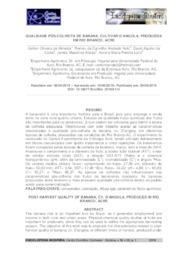Qualidade pós-colheita de banana, cultivar D'Angola, produzida em Rio Branco, Acre.
Qualidade pós-colheita de banana, cultivar D'Angola, produzida em Rio Branco, Acre.
Author(s): ALMEIDA, U. O. de; ANDRADE NETO, R. de C.; COSTA, D. A. da; ARAÚJO, J. M. de; LUNZ, A. M. P.
Summary: A bananeira é uma importante frutífera para o Brasil, pois gera emprego e renda tanto na zona rural quanto urbana. Estudos de qualidade físico-químicas dos frutos são importantes para os produtores, já que podem ser utilizados para definir a época de colheita adequada. Objetivou-se com este trabalho avaliar as características relacionadas à qualidade pós-colheita de banana, cv. D'angola, em diferentes épocas de colheita, produzidas nas condições de Rio Branco-AC. O experimento foi conduzido no Campo Experimental da Embrapa Acre, sendo utilizado delineamento em blocos casualizados com quatro tratamentos e cinco repetições. Os tratamentos foram compostos pelas épocas de colheita de fevereiro, março, abril e maio de 2014. Avaliou-se o comprimento e o diâmetro do fruto, a acidez total titulável (ATT), o teor de sólidos solúveis totais (SST), a relação SST/ATT (Ratio) e o potencial hidrogeniônico (pH), além da luminosidade (L*), cromaticidade (C*) e ângulo ºHue. Os valores médios obtidos foram: comprimento do fruto= 27,35 cm; diâmetro do fruto= 50,63 mm; ATT= 0,54; SST= 17,48 °Brix; Ratio= 34,22; pH= 4,86; L*= 65,83; C*= 50,27; e ºHue= 85,27. As épocas de colheitas não influenciaram nas características pós-colheita dos frutos de bananeiras avaliados. As bananas produzidas entre fevereiro e maio possuem qualidade pós-colheita dentro do padrão aceito para comercialização. The banana tree is an important fruit for Brazil, as it generates employment and income in both rural and urban areas. Physical-chemical quality studies of fruits are important for producers, since they can be used to define the appropriate harvesting season. The objective of this work was to evaluate the characteristics related to postharvest quality of banana, cv. D'angola, at different times of harvest, produced under the conditions of Rio Branco-AC. The experiment was conducted in the Experimental Field of Embrapa Acre, using a randomized block design with four treatments and five replicates. The treatments were composed by the harvesting dates of February, March, April and May of 2014. The length and diameter of the fruit, total titratable acidity (ATT), total soluble solids (TSS), SST/ATT (Ratio) and hydrogenation potential (pH), besides luminosity (L*), chromaticity (C*) and ºHue angle. The average values obtained were: fruit length= 27.35 cm; fruit diameter= 50.63 mm; ATT= 0.54; TSS= 17.48 °Brix; Ratio= 34.22; pH= 4.86; L*= 65.83; C*= 50.27; and ºHue= 85.27. The harvesting times did not influence the post-harvest characteristics of the evaluated banana fruits. Bananas produced between February and May have post-harvest quality within the accepted standard for marketing.
Publication year: 2019
Types of publication: Journal article
Unit: Embrapa Acre
Keywords: Acre, Agronomic traits, Amazonia Occidental, Amazônia Ocidental, Banana, Calidad de la fruta, Campo Experimental, Características Agronômicas, Comportamento de Variedade, D'Angola, Embrapa Acre, Ensayos de variedades, Fruit quality, Fruto, Musa sp, Postharvest treatment, Pós-Colheita, Qualidade, Rio Branco (AC), Tratamiento postcosecha, Variety trials, Western Amazon
Observation
Some of Embrapa's publications are published as ePub files. To read them, use or download one of the following free software options to your computer or mobile device. Android: Google Play Books; IOS: iBooks; Windows and Linux: Calibre.
Access other publications
Access the Agricultural Research Database (BDPA) to consult Embrapa's full library collection and records.
Visit Embrapa Bookstore to purchase books and other publications sold by Embrapa.

